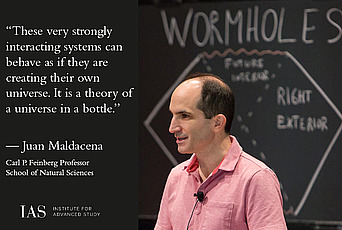
Decades later, string theory continues its march toward Einstein’s dream
In an opinion piece for The Washington Post, Brian Greene, Member (1992–93) in the Schools of Mathematics and Natural Sciences, argues that scholars should continue exploring string theory, even in the absence of experimental verification.
According to Greene, string theory presents a promising avenue for bridging the gap between two highly successful but contradictory pillars of physics: Einstein's theory of general relativity and quantum mechanics. However, he states that string theory "has yet to produce any definitive, testable predictions."
Nevertheless, it has resulted in some groundbreaking ideas. One such body of work, discussed by Greene, is that of Juan Maldacena, Carl P. Feinberg Professor in the School of Natural Sciences. Maldacena's key contribution is concerned with what Greene refers to as "duality." His work "suggests that a three-dimensional realm of space can be well described by processes occurring on a thin, two-dimensional shell surrounding it, much like a hologram — a flat, two-dimensional piece of plastic that generates a three-dimensional image." The contributions of Leonard Susskind, Member (1997) and Visitor (1995) in the School of Natural Sciences, are also acknowledged.
Leveraging holographic duality might reveal "that quantum mechanics and general relativity are already deeply connected" and that the "shotgun wedding" style efforts to fuse the two that are currently undertaken by scientists may be unnecessary. In Greene's words, "the only way to find out is to press onward."
Read the article in full at The Washington Post.


